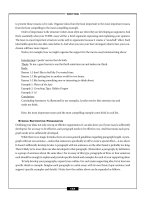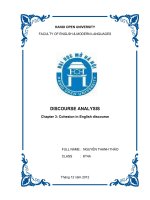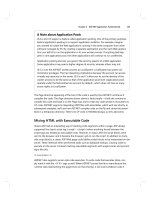Success step english 3 pdf
Bạn đang xem bản rút gọn của tài liệu. Xem và tải ngay bản đầy đủ của tài liệu tại đây (97.25 KB, 6 trang )
98
1. Locate the place. If the question calls for rounding to the nearest ten, look at the tens place. Notice the place
digit. Realize that the place digit will either stay the same or go up one.
2. Look at the digit to the right of the place digit—the right-hand neighbor.
3. If the right-hand neighbor is less than 5, the place digit stays the same.
4. If the right-hand neighbor is 5 or more, the place digit goes up one.
5. If the place digit is 9, and the right-hand neighbor is 5 or more, then turn the place digit to 0 and raise the
left-hand neighbor up one.
6. If instead of a place, the question calls for rounding to a certain number of significant digits, count that num-
ber of digits starting from the left to reach the place digit. Now start with step 1.
7. If the specified place was to the left of the decimal point, change all the digits to 0 that are to the right of the
place digit.
3. The digit is 9; the 9 will either stay 9 or go to 0.
The number 6 is to the right of 9; it is more than
5, so change 9 to 0 and apply step 5, raising the 2
to the left of 9 to 3. Now apply step 7, and change
digits to the right of the tens place to 0. The
answer is 300.
4. Here you need to apply step 6. Two places from
the left is the ten thousands digit, a 4. Now apply
step 1 and work through the steps: The digit is 4,
so it will either stay 4 or go up to 5. Since the
right-hand neighbor is 5, change the 4 to 5. Now
apply step 7 and change all digits to the right of
your new 5 to zero. The answer is 350,000.
Estimation
Estimation requires rounding numbers before adding,
subtracting, multiplying, or dividing. If you are given
numerical answers, you might just want to multiply
the two numbers without estimation and pick the
answer that is the closest. Most likely, however, the
problem will be more complicated than that.
Sample Estimation Question
5. 42 × 57 is closest to
a. 45 × 60.
b. 40 × 55.
c. 40 × 50.
d. 40 × 60.
e. 45 × 50.
Answer to Sample Estimation Question
Here’s how you could use the steps to answer the sam-
ple question:
1. You can round 42 down and 57 up, resulting in
answer d.
2. Rounding the numbers to one significant digit
yields d also.
3. Eliminate. a. Eliminated: 45 is further from 42
than is 40. b. Maybe. c. Eliminated: 50 is further
from 57 than is 60. e. Eliminated: 45 is further
from 42 and 50 is further from 57.
4. Check the remaining answers. The product of
choice b is 2,200. The product of choice d is
2,400. The actual product is 2,394, which makes
d the closest, and therefore the correct answer.
Seven Success Steps for Rounding Questions
99
To do a problem like this, you might want to try some of the following strategies:
1. See whether you can round one number up and the other one down. This works if by so doing you are adding
nearly the same amount to one number as you are subtracting from the other. Rounding one up and one
down makes the product most accurate. For example, if the numbers were 71 and 89, you take one from
71 to get 70 and add one to 89 to get 90. 70 × 90 is very close to 71 × 89.
2. An estimation question may be on the test in order to test your rounding skills. Round the numbers to one
significant digit, or to the number of significant digits to which the numbers in the answers have been
rounded. Find that answer and consider it as a possible right answer.
3. Eliminate answers that are further away from those you obtained after doing steps 1 and 2. For example,
for 71 and 89, if answers given were 70 × 85 and 70 × 90, you can eliminate the former choice because 85 is
further from 89 than is 90.
4. After eliminating, you can always multiply (subtract, add, divide) out the remaining answers to make sure your
answer is correct.
Decimal Equivalents
You may be asked to compare two numbers in order
to tell which one is greater. In many cases, you will
need to know some basic decimal and percentage
equivalents.
Decimal-Fraction Questions
See how many of these you already know. For ques-
tions 6–11, state the decimal equivalent.
6.
ᎏ
1
2
ᎏ
7.
ᎏ
3
4
ᎏ
8.
ᎏ
4
5
ᎏ
9.
ᎏ
1
8
ᎏ
10.
ᎏ
1
3
ᎏ
11.
ᎏ
1
6
ᎏ
For questions 12–14, tell which number is greater.
12.a. 0.93
b. 0.9039
13.a. 0.339
b.
ᎏ
1
3
ᎏ
14.a.
ᎏ
4
9
5
1
ᎏ
b. 0.52
Answers
6. 0.5
7. 0.75
8. 0.8
9. 0.125
10. 0.33
ᎏ
1
3
ᎏ
or 0.33
11. 0.16
ᎏ
2
3
ᎏ
or 0.166
12.a. To compare these numbers more easily, add
zeros after the shorter number to make the num-
bers both the same length: 0.93 = 0.9300. Com-
pare 0.9300 and 0.9039. Then take out the
decimals. You can see that 9,300 is larger than
9,039.
13.a. Since
ᎏ
1
3
ᎏ
= 0.33, extending the number would
yield 0.333
–
. (A line over a number means the
number repeats forever.) 333 is smaller than 339.
14. b. Instead of dividing the denominator (91) into
the numerator (45), look to see whether the two
choices are close to any common number. You
might notice that both numbers almost equal
ᎏ
1
2
ᎏ
.
Four Success Steps for Estimation Problems
45 is less than half of 91, so
ᎏ
4
9
5
1
ᎏ
is less than half.
Half in decimals is 0.5 or 0.50; 0.52 is greater than
0.50, so it is greater than half. Thus, b is larger.
Decimal-Percentage Equivalents
You already know that when you deposit money in an
account that earns 5% interest, you multiply the
money in the bank by 0.05 to find out your interest for
the year. 5% in decimal form is 0.05.
The percent always looks larger. Here are some
examples:
Number Percent
0.05 5%
0.9 90%
0.002 0.2%
0.0004 0.04%
3 300%
Questions
Change the following numbers to percents.
15. 0.07
16. 0.8
17. 0.45
18. 6.8
19. 97
20. 345
21. 0.125
Change the following percents to decimals.
22. 5%
23. 0.7%
24. 0.09%
25. 49%
26. 764%
Answers
15. 7%
16. 80%
17. 45%
18. 680%
19. 9,700%
20. 34,500%
21. 12.5%
22. 0.05
23. 0.007
24. 0.0009
25. 0.49
26. 7.64
HOT TIP
To change a percent to a decimal, move the decimal point
two places to the left. To change a decimal to a percent,
move the decimal point two places to the right. If there is
no decimal indicated in the number, it is assumed that the
decimal is after the ones place, or to the right of the
number.
–CBEST MINI-COURSE–
100
Common Equivalents
Here are some common decimal, percent, and fraction
equivalents you should have at your fingertips. A line
over a number indicates that the number is repeated
indefinitely.
CONVERSION TABLE
Decimal % Fraction
0.25 25%
ᎏ
1
4
ᎏ
0.50 50%
ᎏ
1
2
ᎏ
0.75 75%
ᎏ
3
4
ᎏ
0.10 10%
ᎏ
1
1
0
ᎏ
0.20 20%
ᎏ
1
5
ᎏ
0.40 40%
ᎏ
2
5
ᎏ
0.60 60%
ᎏ
3
5
ᎏ
0.80 80%
ᎏ
4
5
ᎏ
0.333
–
33
ᎏ
1
3
ᎏ
%
ᎏ
1
3
ᎏ
0.666
–
66
ᎏ
2
3
ᎏ
%
ᎏ
2
3
ᎏ
For more on fraction and decimal equivalents, see the
next lesson.
Math 4: Fractions
Fractions are the nemesis of many a CBEST taker.
Consider yourself fortunate if you have had few prob-
lems with them. Now that you have had a few more
years of education and are a little wiser, fractions may
not be as intimidating as they once seemed.
Comparing Fractions
The Laser Beam Method
A CBEST question may ask you to compare two frac-
tions, or a fraction to a decimal. To compare two frac-
tions, use the laser beam method: 1. Two laser beams
are racing toward each other. 2. They both hit numbers
and bounce off up to the number in the opposite cor-
ner multiplying the two numbers as they go. 3. Exam-
ine the numbers they came up with. The largest num-
ber is beside the largest fraction. Use the laser beam
method to compare
ᎏ
1
5
6
ᎏ
and
ᎏ
2
5
ᎏ
.
32 > 25, so
ᎏ
2
5
ᎏ
>
ᎏ
1
5
6
ᎏ
Practice
Which number is the largest?
1. a) 0.25
b)
ᎏ
1
4
1
8
ᎏ
2. a)
ᎏ
4
5
ᎏ
b) 0.75
3. a)
ᎏ
3
7
ᎏ
b)
ᎏ
4
9
ᎏ
Which number is the smallest?
4. a)
ᎏ
1
3
3
ᎏ
b)
ᎏ
1
2
1
ᎏ
5. a) 0.95
b)
ᎏ
1
9
0
ᎏ
6. a)
ᎏ
1
3
ᎏ
b) 0.3387
HOT TIP
To change a fraction into a decimal, you simply divide the
denominator of the fraction into the numerator, like this:
ᎏ
3
8
ᎏ
= 0.375
8
͉
3
ෆ
.0
ෆ
0
ෆ
0
ෆ
24
60
56
40
5
16
2
5
25
32
–CBEST MINI-COURSE–
101
Answers
1.a.11 ÷ 48 = 0.23 < 0.25
2.a.
ᎏ
4
5
ᎏ
= 0.8 80 > 75
3. b. Use the laser beam method.
4. b. Use the laser beam method.
5. b.
ᎏ
1
9
0
ᎏ
= 0.9 90 < 95
6.a.
ᎏ
1
3
ᎏ
= 0.33 3,387 > 3,333
Reducing and Expanding
Fractions
Fractions can be reduced by dividing the same number
into both the numerator and the denominator.
■
ᎏ
2
4
ᎏ
=
ᎏ
1
2
ᎏ
because both the numerator and denomi-
nator can be divided by 2.
■
ᎏ
2
3
4
6
ᎏ
=
ᎏ
2
3
ᎏ
because both the numerator and denomi-
nator can be divided by 12.
Fractions can be expanded by multiplying the
numerator and the denominator by the same number.
■
ᎏ
1
8
ᎏ
=
ᎏ
1
2
6
ᎏ
=
ᎏ
4
5
0
ᎏ
because the original numerator and
the denominator are both multiplied by 2, and
then by 5.
Adding and Subtracting Fractions
When adding fractions that have the same denomina-
tors, add the numerators, and then reduce if necessary:
ᎏ
1
4
ᎏ
+
ᎏ
5
4
ᎏ
=
ᎏ
6
4
ᎏ
= 1
ᎏ
2
4
ᎏ
= 1
ᎏ
1
2
ᎏ
When subtracting fractions that have the same
denominators, subtract the numerators. Then reduce
if necessary:
ᎏ
5
7
ᎏ
−
ᎏ
3
7
ᎏ
=
ᎏ
2
7
ᎏ
When adding or subtracting fractions with dif-
ferent denominators, find common denominators
before performing the operations. For example, in the
problem
ᎏ
3
8
ᎏ
+
ᎏ
1
6
ᎏ
, the lowest common denominator of 6
and 8 is 24.
Convert both fractions to 24ths:
ᎏ
3
8
ᎏ
=
ᎏ
2
9
4
ᎏ
ᎏ
1
6
ᎏ
=
ᎏ
2
4
4
ᎏ
Add the new fractions:
ᎏ
2
9
4
ᎏ
+
ᎏ
2
4
4
ᎏ
=
ᎏ
1
2
3
4
ᎏ
To subtract instead of add the fractions above,
after finding the common denominator, subtract the
resulting numerators:
ᎏ
2
9
4
ᎏ
−
ᎏ
2
4
4
ᎏ
=
ᎏ
2
5
4
ᎏ
.
When adding mixed numbers, there is no need to
turn the numbers into improper fractions. Simply add
the fraction parts. Then add the integers. When fin-
ished, add the two parts together. Don’t forget to
“carry” if the fractions add up to more than one.
13
ᎏ
5
7
ᎏ
+ 6
ᎏ
6
7
ᎏ
19
ᎏ
1
7
1
ᎏ
ᎏ
1
7
1
ᎏ
= 1
ᎏ
4
7
ᎏ
1
ᎏ
4
7
ᎏ
+ 19 = 20
ᎏ
4
7
ᎏ
Subtraction uses the same principle. Subtract the
bottom fraction from the top fraction, and the bottom
integer from the top integer. If the top fraction is
smaller than the bottom one, then take the following
steps:
1. Notice the common denominator of the
fractions.
2. Add that number to the numerator of the top
fraction.
3. Subtract 1 from the top integer.
4. Subtract as usual.
Suppose the problem above were a subtraction
problem instead of addition:
–CBEST MINI-COURSE–
102
13
ᎏ
5
7
ᎏ
− 6
ᎏ
6
7
ᎏ
1. Notice the common denominator
of the fractions: 7
2. Add that number to the numerator
of the top fraction: 5 + 7 = 12
3. Subtract one from the top integer: 13 − 1 = 12
4. Subtract as usual: 12
ᎏ
1
7
2
ᎏ
−6
ᎏ
6
7
ᎏ
6
ᎏ
6
7
ᎏ
Multiplying and Dividing Fractions
When multiplying fractions, simply multiply the
numerators and then multiply the denominators:
ᎏ
5
6
ᎏ
×
ᎏ
7
8
ᎏ
=
ᎏ
3
4
5
8
ᎏ
When dividing, turn the second fraction upside-
down, then multiply across:
ᎏ
1
2
ᎏ
÷
ᎏ
2
3
ᎏ
is the same as
ᎏ
1
2
ᎏ
×
ᎏ
3
2
ᎏ
=
ᎏ
3
4
ᎏ
When working with problems that involve mixed
numbers such as 6
ᎏ
1
2
ᎏ
× 5
ᎏ
1
3
ᎏ
, change the numbers to
improper fractions before multiplying. With 6
ᎏ
1
2
ᎏ
,
multiply the denominator, 2, by the whole number, 6,
to get 12, then add the numerator, 1, for a total of 13.
Place 13 over the original denominator, 2. The result is
ᎏ
1
2
3
ᎏ
.
When multiplying or dividing a fraction and an
integer, place the integer over 1 and proceed as if it
were a fraction.
13 ×
ᎏ
1
2
ᎏ
=
ᎏ
1
1
3
ᎏ
×
ᎏ
1
2
ᎏ
=
ᎏ
1
2
3
ᎏ
= 6
ᎏ
1
2
ᎏ
Choosing an Answer
When you come up with an answer where the numer-
ator is more than the denominator, the answer may be
given in that form, as an improper fraction. But if the
answers are mixed numbers, divide the denominator
into the numerator. Any remainder is placed over the
original denominator. In the case of
ᎏ
20
6
8
ᎏ
, 208 divided
by 6 is 34 with a remainder of 4 yielding 34
ᎏ
4
6
ᎏ
. This
answer probably will not be there, so reduce
ᎏ
4
6
ᎏ
to
ᎏ
2
3
ᎏ
.If
ᎏ
20
6
8
ᎏ
is not an answer choice, 34
ᎏ
2
3
ᎏ
probably will be. But
don’t worry about having to choose between these two
answers. Since they signify the same amount, the test
would not be valid if both
ᎏ
20
6
8
ᎏ
and 34
ᎏ
2
3
ᎏ
were there
unless the question specifically asked for a fully
reduced answer.
HOT TIP
When you’re working with two fractions where the
numerator of one fraction can be divided by the same
number as the denominator of the other fraction, you can
reduce even before you multiply:
6
ᎏ
1
2
ᎏ
× 5
ᎏ
1
3
ᎏ
=
ᎏ
1
2
3
ᎏ
×
ᎏ
1
3
6
ᎏ
Divide both the 2 and the 16 by 2:
HOT TIP
When adding or subtracting fractions, you can use the
laser beam method.
1. First change to improper fractions, then multiply
crosswise:
2. Next, multiply the denominators: 6 × 7 = 42
3. Add or subtract the top numbers as appropriate and
place them over the multiplied denominator to get your
answer: 7 + 18 = 25
ᎏ
2
4
5
2
ᎏ
–CBEST MINI-COURSE–
103
1
6
3
7
7
18
1
6
3
7
+
=
13
2
16
3
104
3
2
3
×
==
1
8
34









